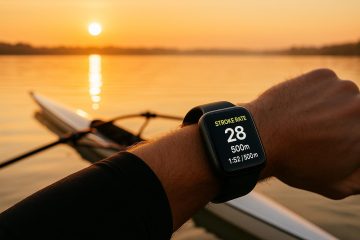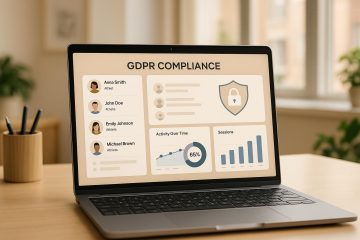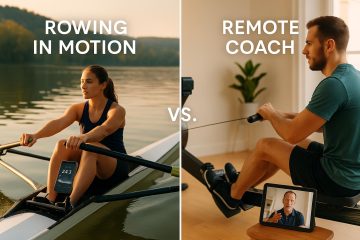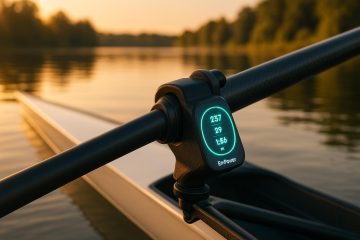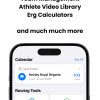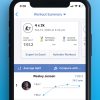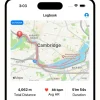
GDPR Compliance in Rowing Coaching Platforms
Handling personal data responsibly is a must for rowing coaching platforms, especially for those serving EU users. The General Data Protection Regulation (GDPR), active since May 2018, requires platforms to safeguard user data, ensure transparency, and secure explicit consent for data collection. Non-compliance can result in fines up to €20 million or 4% of global revenue.
Why it matters:
- Platforms process sensitive data like athlete health info, performance metrics, and communication records.
- GDPR enforces user rights, ensuring individuals can access, correct, or delete their data.
- Transparent data handling builds trust between athletes, coaches, and organizations.
Key principles for compliance:
- Collect only necessary data for specific purposes.
- Secure data with encryption and access controls.
- Maintain clear, accessible privacy policies.
- Honor user rights, such as data access, correction, and erasure.
Examples of good practices:
- Platforms like CrewLAB and Spond use encrypted storage and consent management tools.
- Clubs like Weybridge Rowing revamped their data policies, improving member trust.
GDPR isn’t just about avoiding penalties – it’s about creating a secure, trustworthy environment for athletes and coaches. Platforms like RowingList.com help users find services that prioritize data protection.
GDPR Principles and User Rights
Key GDPR Principles
The GDPR outlines seven principles for handling personal data, creating a framework that prioritizes user privacy while ensuring platforms act responsibly and transparently.
Lawfulness, fairness, and transparency are at the core of GDPR compliance. Platforms must handle data in a legal and open manner. For rowing platforms, this means clearly explaining why they collect athlete performance data, contact details, or training logs before gathering any information.
Purpose limitation requires data to be collected only for specific, legitimate reasons. For example, rowing coaching platforms must stick to the stated purpose for which they collected the data and seek fresh consent if they want to use it for something else.
Data minimization emphasizes collecting only the necessary information. For rowing platforms, this might mean limiting data collection to names, contact details, and essential training metrics.
Accuracy obligates platforms to keep data up-to-date and provide athletes with a way to correct any errors quickly.
Storage limitation ensures data is retained only as long as it serves its intended purpose. For instance, if an athlete leaves a rowing program, their personal information should be deleted after a reasonable amount of time.
Integrity and confidentiality require strong security measures to protect personal data from breaches or unauthorized access. This includes encryption, restricted access, and regular security audits.
Accountability demands that platforms prove their compliance with these principles. This can be achieved through documented processes, clear policies, and regular reviews.
These principles lay the foundation for the rights granted to users under GDPR, which are outlined below.
User Rights Under GDPR
Building on these principles, GDPR grants individuals specific rights that rowing coaching platforms must honor, giving users control over their personal data and requiring platforms to address their requests promptly.
The right of access lets users request a copy of all personal data a platform holds about them. The right to rectification allows them to correct inaccurate or incomplete data. The right to erasure, often called the "right to be forgotten", enables users to request the deletion of their data when applicable.
The right to restrict processing lets users limit how their data is used while retaining it. For instance, an athlete might ask for their data to remain on file but not be processed while disputing its accuracy.
The right to data portability allows users to export their data in a machine-readable format, making it easier to transfer their training history to another coaching platform.
The right to object gives users the ability to oppose specific types of data processing, such as direct marketing or automated decision-making. For example, athletes can opt out of promotional emails or request not to have their performance evaluated solely by algorithms.
Users also have the right to withdraw consent at any time, stopping any further use of their data based on that consent. Additionally, the right not to be subject to automated decision-making ensures that individuals aren’t solely judged by algorithms without any human oversight.
In 2022, Weybridge Rowing Club in the UK revamped its data protection practices. They introduced a dedicated contact for handling data access requests and replaced pre-ticked consent boxes with more transparent options. As a result, the club reported zero data breaches and saw a boost in member trust regarding data handling.
These rights, combined with the GDPR principles, create a solid framework that protects user privacy while helping rowing coaching platforms maintain trust and operate efficiently within their communities.
Practical Steps to GDPR Compliance Success 2024
How Rowing Coaching Platforms Can Meet GDPR Requirements
Navigating GDPR compliance might seem daunting, but with clear consent processes, strong security measures, and transparent privacy policies, rowing coaching platforms can safeguard personal data while fostering trust with athletes and coaches. Here’s how platforms can handle consent, security, and transparency effectively.
Getting User Consent
Start by securing clear and explicit consent before collecting any personal data. Users need to know exactly what information is being gathered, why it’s necessary, and how it will be used.
Consent should be specific and broken into categories. For instance, instead of asking for a blanket agreement, request permission separately for things like collecting performance metrics, storing contact details, or accessing training videos. This approach respects users’ control over their data and aligns with GDPR’s principle of data minimization.
Keep a record of every consent interaction, including the date, method, and agreed terms. Automated systems can streamline this process, creating audit trails that simplify regulatory reviews.
To illustrate, in 2023, Spond – a team management app popular among rowing coaches – introduced encrypted messaging and GDPR-compliant consent management. This update led to a 30% boost in user trust scores and positive feedback from rowing clubs across the EU.
Equally important, users must have an easy way to withdraw consent. Offer clear opt-out options in user dashboards and handle withdrawal requests promptly. This ensures users can manage their data preferences without feeling penalized.
Data Security Measures
Once consent is secured, protecting personal data becomes the next priority. GDPR mandates both technical and organizational measures to keep data safe.
Encryption is a must. Sensitive data should be encrypted both in transit and at rest, ensuring that even if intercepted, it’s unreadable to unauthorized parties.
Access control is another critical step. Limit access to authorized personnel and implement role-based permissions. For example, coaches should only access data for their assigned athletes. Adding multi-factor authentication enhances security further.
Take CrewLAB as an example. By offering secure data storage, access logs, and user-controlled privacy settings, the platform has gained traction among rowing teams in the UK and EU.
Regular security audits are essential. These include identifying vulnerabilities, updating software, and monitoring access logs for unusual activity. Engaging cybersecurity experts for penetration testing can also help uncover weak points before they become threats.
Finally, data should be stored in secure, certified environments. Look for hosting providers with certifications like ISO 27001, SOC 1, or SOC 2 to ensure compliance with international security standards.
Privacy Policies and Transparency
A transparent privacy policy is the cornerstone of GDPR compliance. This document should clearly explain how user data is handled – without drowning readers in legal jargon.
Use simple, straightforward language to outline what data you collect, why it’s needed, how long it’s stored, and who it’s shared with. For example, explain that training data is used to create performance reports or that contact details are required for scheduling sessions.
Make your privacy policy easy to find. Include links on your website, app settings, and during the signup process, so users can access data practices effortlessly.
Your policy should also highlight user rights, detailing how individuals can access, correct, delete, or transfer their data. Provide clear contact information for data protection inquiries and commit to responding within defined timeframes.
British Rowing serves as a great example. The organization conducted a full data audit and revamped its membership platform to meet GDPR standards. By introducing explicit consent forms and a transparent privacy policy, it set a new standard for affiliated clubs starting in 2018.
Regular updates to your privacy policy show your commitment to data protection. Review it annually and notify users of major changes. Offering privacy dashboards where users can manage their data preferences is another way to empower users while meeting GDPR requirements.
How RowingList.com Supports GDPR Compliance

RowingList.com takes data protection seriously, helping users find rowing coaching platforms that prioritize GDPR compliance. By curating a directory of rowing-related services, the platform simplifies the process of identifying and comparing coaching options based on their privacy practices.
Finding GDPR-Compliant Platforms on RowingList.com
RowingList.com makes it easy for users to locate GDPR-compliant coaching platforms. Each listing highlights the service’s approach to data protection, offering details like privacy policies, security measures, and compliance status. Links to certifications and policies are also included, giving users a clear understanding of how their personal information is managed.
For example, if you’re comparing virtual rowing coaching platforms, you can quickly see how they stack up in terms of privacy features. One platform might focus on ISO-certified data storage and automated consent tools, while another emphasizes encrypted communication and clear data deletion policies. These side-by-side comparisons help users choose services that meet their privacy standards.
The platform also includes a filtering system, allowing users to specifically search for services that mention GDPR compliance. This feature streamlines the process, ensuring that data protection remains a top priority when selecting a coaching platform.
For users in the U.S., RowingList.com provides helpful context on how GDPR practices relate to domestic privacy standards. This information supports American athletes and coaches in making informed decisions when exploring international rowing services.
GDPR Compliance in Rowing Coaching: Key Takeaways
For rowing coaching platforms, adhering to GDPR isn’t just a legal formality – it’s a critical step in safeguarding user data and earning trust. Whether you’re running a small rowing club or a larger virtual coaching service, following these principles ensures you’re both compliant and fostering confidence among your users.
The basics include securing explicit consent, implementing strong data protection measures, and maintaining clear and accessible privacy policies. These policies should allow users to view, correct, or delete their personal data as needed.
Some standout examples, like Spond and Weybridge Rowing Club, demonstrate how effective GDPR practices can be successfully implemented.
Compliance doesn’t stop at initial implementation. It requires regular audits, updates to privacy policies, and ongoing staff training to stay aligned with GDPR standards. Even smaller clubs are held to these requirements. The consequences for non-compliance are steep – GDPR fines across industries exceeded $1.7 billion in 2022, underscoring the financial stakes.
Platforms like RowingList.com help the rowing community by showcasing services with strong data protection practices. This empowers athletes and coaches to choose platforms that prioritize their privacy and security.
When rowing platforms make data protection a priority, it strengthens trust across the community. Athletes can confidently share performance data, knowing their information is handled with care.
FAQs
What happens if rowing coaching platforms don’t comply with GDPR regulations?
Failing to meet GDPR requirements can spell trouble for rowing coaching platforms. The penalties are steep – fines can reach up to 4% of annual global revenue or €20 million, whichever amount is greater. Beyond the financial hit, there’s also the risk of legal battles and damage to reputation.
Ignoring GDPR rules can also lead to restrictions on how user data is managed. This can disrupt daily operations and weaken the trust users place in the platform. Staying compliant isn’t just about avoiding fines; it’s about preserving credibility and ensuring smooth, trustworthy operations.
How can rowing coaching platforms comply with GDPR by collecting only the data they truly need?
Rowing coaching platforms can align with GDPR requirements by adhering to the data minimization principle. This principle focuses on collecting only the information that’s absolutely necessary for providing coaching services, avoiding any unnecessary or irrelevant data.
To put this into practice, platforms should clearly outline why they need specific data, ensure their requests are limited to that purpose, and routinely review their data-handling practices to stay within compliance. Being transparent with users about the reasons for data collection and how their information will be used is another critical step in meeting GDPR standards.
How can athletes request access to or deletion of their personal data on a rowing coaching platform under GDPR?
Athletes who want to access or delete their personal data can do so by contacting the platform’s data protection officer or customer support team. When making a request, you’ll usually need to share details about your account and verify your identity to ensure the request is legitimate.
According to GDPR regulations, platforms are obligated to respond to these requests within one month. They must either provide the information you’ve asked for or confirm the actions they’ve taken, such as removing your data or fixing any inaccuracies. If you’re unsure about the process, the platform’s privacy policy is a good place to find step-by-step guidance.

